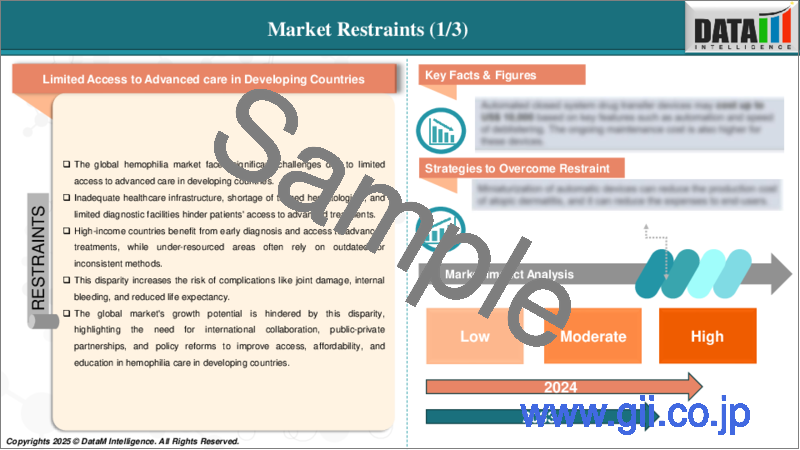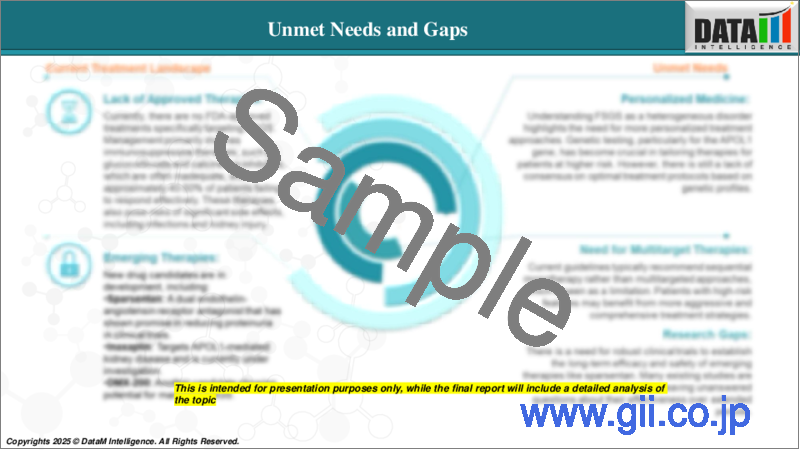|
|
市場調査レポート
商品コード
1297774
血友病の世界市場-2023年~2030年Global Hemophilia Market - 2023-2030 |
||||||
カスタマイズ可能
適宜更新あり
|
|||||||
| 血友病の世界市場-2023年~2030年 |
|
出版日: 2023年06月15日
発行: DataM Intelligence
ページ情報: 英文 195 Pages
納期: 即日から翌営業日
|
- 全表示
- 概要
- 目次
市場概要
血友病の世界市場は2022年に117億米ドルに達し、2030年には180億米ドルに達するなど、有利な成長が予測されています。血友病市場は予測期間2023-2030年にCAGR 5.9%を示すと予測されます。
体内の血液凝固機能に影響を及ぼす様々な症状が出血性疾患として理解されています。傷害をきっかけに、複数の障害が極端で長引く出血を引き起こすことがあります。多くの出血性疾患は遺伝性であるが、肝臓の状態、薬の副作用、赤血球数の低下、ビタミンK欠乏症、その他の要素によって誘発されるものもあります。
市場力学
血友病患者数の増加が、予測期間における血友病世界市場を牽引しています
血友病の有病率の増加が、予測期間中の世界の血友病市場の成長を牽引しています。例えば、米国血友病連盟によると、世界で110万人以上が血友病患者であり、米国では約3万人が血友病患者です。あらゆる人種や経済階層が等しく影響を受けています。
政府の取り組みや資金援助の増加は、世界の血友病市場に将来の成長機会をもたらしています
様々な機関による様々な取り組みや資金提供は、世界の血友病市場に今後数年間の有望な成長機会をもたらします。例えば、2022年3月、国立心肺血液研究所は、血友病治療法を設計するための複数の研究機関による活動を主導するインディアナ大学医学部の研究者に1,200万米ドルの資金を提供しました。
COVID-19影響分析
COVID-19分析には、COVID前シナリオ、COVIDシナリオ、COVID後シナリオに加え、価格力学(COVID前シナリオと比較したパンデミック中およびパンデミック後の価格変動を含む)、需給スペクトラム(取引制限、封鎖、およびその後の問題による需給の変化)、政府の取り組み(政府機関による市場、セクター、産業を活性化させる取り組み)、メーカーの戦略的取り組み(COVID問題を緩和するためにメーカーが行ったことをここで取り上げる)が含まれます。
ロシア・ウクライナ戦争の影響分析
ロシア・ウクライナ戦争は、紛争によりウクライナや近隣の州からの患者が治療を受けられなくなったため、市場にマイナスの影響を与えました。
例えば、世界血友病連盟は、紛争に影響を受けているウクライナや近隣諸国の国内加盟団体(NMO)、血友病治療センター(HTC)、その他の利害関係者と協力し、影響を受けている人々を最善の方法で支援するために状況を注視しています。
さらに、ロシアとウクライナは世界の臨床試験のハブとみなされており、この現状はこれらの地域における臨床研究プロジェクトを阻害しているため、世界の血友病市場の成長に悪影響を及ぼしています。
世界不況の影響分析
ヘルスケア業界は不況と完全に無縁というわけではなく、過去の金融不況の際にも医療機関は解雇や雇用を考えていました。とはいえ、この業界はその本質的な性質から、他のセクターよりはうまく対処しています。しかし、インフレが続く中、景気後退の危機は市場を脅かしています。不況の長期化に対する緊張の高まり。
人工知能の影響分析
AIは、血友病の新しい治療法の設計と開発に大きく活用され、今後数年間の世界血友病市場の成長にプラスの影響を与えます。例えば、デューク大学(ノースカロライナ州ダーラム)のプロジェクトは、ファイザーからの資金提供を受け、遺伝子治療/遺伝子導入のような一回限りの治療法の可能性に重点を置いた治療法の開発に機械学習/人工知能を用いることに集中しています。
目次
第1章 調査手法と調査範囲
第2章 定義と概要
第3章 エグゼクティブサマリー
第4章 市場力学
- 影響要因
- 促進要因
- 調査活動の活発化
- 普及率の高まり
- 抑制要因
- 高い治療費
- 機会
- 政府の取り組み
- 影響分析
- 促進要因
第5章 産業分析
- ポーターの5フォース分析
- 規制分析
- 価格分析
- 特許分析
- 疫学分析
- 償還シナリオ
第6章 COVID-19分析
第7章 ロシア・ウクライナ戦争分析
第8章 世界不況分析
第9章 人工知能インパクト分析
第10章 疾患タイプ別
- 血友病A
- 血友病B
- その他
第11章 製品タイプ別
- 遺伝子組換え凝固因子製剤
- 濃縮血液凝固因子製剤
- 血漿由来凝固因子製剤
- その他
第12章 治療法別
- 補充療法
- 遺伝子治療
- 免疫寛容導入療法
第13章 地域別
- 北米
- 米国
- カナダ
- メキシコ
- 欧州
- ドイツ
- 英国
- フランス
- イタリア
- スペイン
- その他欧州
- 南米
- ブラジル
- アルゼンチン
- その他南米
- アジア太平洋
- 中国
- インド
- 日本
- オーストラリア
- その他アジア太平洋地域
- 中東・アフリカ
第14章 競合情勢
- 競合シナリオ
- 市場シェア分析
- M&A分析
第15章 企業プロファイル
- Bayer AG
- 企業概要
- 製品ポートフォリオと説明
- 財務概要
- 主な発展
- BioMarin Pharmaceutical, Inc.
- CSL Behring
- Kedrion S.p.A
- Novo Nordisk
- Pfizer, Inc.
- Roche(Chugai Pharmaceutical Co.)
- Sanofi(Genzyme Corporation)
- Takeda Pharmaceutical(Shire Plc.)
- Octapharma
第16章 付録
Market Overview
The Global Hemophilia Market reached USD 11.7 billion in 2022 and is projected to witness lucrative growth by reaching up to USD 18 billion by 2030. The Hemophilia Market is expected to exhibit a CAGR of 5.9% during the forecast period 2023-2030.
A spectrum of conditions impacting the body's blood clotting function is comprehended as bleeding disorders. Heeding an injury, multiple disorders can induce extreme and prolonged bleeding. Many bleeding conditions are inherited, although some are induced because of liver conditions, medication side effects, low red blood cell count, vitamin K deficiency, and additional elements.
Market Dynamics
The growing number of hemophilia cases drives the Global Hemophilia Market in the forecast period.
The growing prevalence of hemophilia is driving the global hemophilia market growth during the forecast period. For instance, according to the Hemophilia Federation of America, more than 1.1 million individuals globally live with hemophilia, and approximately 30,000 are in the United States. All races and economic classes are impacted equally.
The increasing government initiatives and funding provide the global hemophilia market with future growth opportunities.
The different initiatives and funding by various organizations present the global hemophilia market with prospective growth opportunities in the upcoming years. For instance, in March 2022, the National Heart, Lung, and Blood Institute provided funding of USD 12 million to an Indiana University School of Medicine researcher who will lead a multi-institute action to design hemophilia treatments.
COVID-19 Impact Analysis
The COVID-19 analysis includes Pre-COVID Scenario, COVID Scenario, and Post-COVID Scenario along with Pricing Dynamics (Including pricing change during and post-pandemic comparing it to pre-COVID scenarios), Demand-Supply Spectrum (Shift in demand and supply owing to trading restrictions, lockdown, and subsequent issues), Government Initiatives (Initiatives to revive market, sector or Industry by Government Bodies) and Manufacturers Strategic Initiatives (What manufacturers did to mitigate the COVID issues will be covered here).
Russia-Ukraine War Impact Analysis
The Russia-Ukraine war had a negative influence on the market because of the conflict, patients from Ukraine and neighboring provinces could not receive care; however, various organizations stood up and tried to help the individuals.
For instance, the World Federation of Hemophilia teams is closely monitoring the situation to support best those who are affected via cooperating with national member organizations (NMOs), hemophilia treatment centers (HTCs), and additional stakeholders in Ukraine and neighboring nations that are influenced by the dispute.
Additionally, Russia and Ukraine are regarded as clinical trial hubs of the world, and this current circumstance is impeding the clinical research projects in these regions, thus negatively influencing the global hemophilia market growth.
Global Recession Impact Analysis
The healthcare industry is not completely immune to recession, as healthcare institutions thought firings and employment during past financial downturns. That stated, the industry does cope finer than other sectors because of its essential nature. However, the danger of recession threatens the market as inflation persists increasing. The elevated extent of tension about the persistent recession.
Artificial Intelligence Impact Analysis
AI is largely utilized in designing and developing new treatment options for hemophilia, positively impacting the Global Hemophilia Market growth in the forthcoming years. For instance, the Duke University Durham, NC projects considered for Pfizer funding will concentrate on employing Machine Learning/Artificial Intelligence in developing treatments with an emphasis on arising potential one-time therapies like genetic medicine/gene transfer.
Segment Analysis
The Global Hemophilia Market is segmented based on disease type, product type, therapy, and region.
The gene therapy segment is estimated to hold a global market share by 2030.
The segment is estimated to hold around 35.9% of the Global Hemophilia Market by 2030 due to the increased funding and investments in gene therapy for hemophilia. For instance, Amarna Therapeutics, a privately held European biotechnology company, received €5 million (approximately $5.6 million) in new funding, which it intends to utilize for developing its lead development, AMA005, an investigational gene treatment that seeks to correct blood clotting in individuals with hemophilia B.
Geographical Analysis
Europe is estimated to hold the 2nd largest share of the Global Hemophilia Market during the forecast period.
The market developments such as mergers, acquisitions, product launches, product approvals, and collaborations, and the Europe region is estimated to hold around 28.7% of the total global hemophilia market by 2030. For instance, in September 2022, Novo Nordisk, a Danish multinational pharmaceutical company headquartered in Bagsværd, Denmark, acquired Forma Therapeutics, Holdings, a clinical-stage biopharmaceutical company focused on transforming the lives of patients with sickle cell disease (SCD) and rare blood disorders.
Competitive Landscape
The major global players in the market include: Bayer AG, BioMarin Pharmaceutical, Inc., CSL Behring, Kedrion S.p.A, Novo Nordisk, Pfizer, Inc., Roche (Chugai Pharmaceutical Co.), Sanofi (Genzyme Corporation), and Takeda Pharmaceutical (Shire Plc.), Grifols among others.
Why Purchase the Report?
- To visualize the Global Hemophilia Market segmentation based on disease type, product type, therapy, and region and understand key commercial assets and players.
- Identify commercial opportunities by analyzing trends and co-development.
- Excel data sheet with numerous data points of hemophilia market-level with all segments.
- PDF report consists of a comprehensive analysis after exhaustive qualitative interviews and an in-depth study.
- Product mapping available as Excel consisting of key products of all the major players.
The Global Hemophilia Market Report Would Provide Approximately 53 Tables, 54 Figures And 195 pages.
Target Audience 2023
- Manufacturers/ Buyers
- Industry Investors/Investment Bankers
- Research Professionals
- Emerging Companies
Table of Contents
1. Methodology and Scope
- 1.1. Research Methodology
- 1.2. Research Objective and Scope of the Report
2. Definition and Overview
3. Executive Summary
- 3.1. Snippet by Disease Type
- 3.2. Snippet by Product Type
- 3.3. Snippet by Therapy
4. Dynamics
- 4.1. Impacting Factors
- 4.1.1. Drivers
- 4.1.1.1. Increasing Research Activities
- 4.1.1.2. Growing Prevalence
- 4.1.2. Restraints
- 4.1.2.1. High Treatment Costs
- 4.1.3. Opportunity
- 4.1.4. Government Initiatives
- 4.1.5. Impact Analysis
- 4.1.1. Drivers
5. Industry Analysis
- 5.1. Porter's 5 Forces Analysis
- 5.2. Regulatory Analysis
- 5.3. Pricing Analysis
- 5.4. Patent Analysis
- 5.5. Epidemiology Analysis
- 5.6. Reimbursement Scenarios
6. COVID-19 Analysis
- 6.1. Analysis of COVID-19
- 6.1.1. Scenario Before COVID-19
- 6.1.2. Scenario During COVID-19
- 6.1.3. Post COVID-19 or Future Scenario
- 6.2. Pricing Dynamics Amid COVID-19
- 6.3. Demand-Supply Spectrum
- 6.4. Government Initiatives Related to the Market During the Pandemic
- 6.5. Manufacturers' Strategic Initiatives
- 6.6. Conclusion
7. Russia-Ukraine War Analysis
8. Global Recession Analysis
9. Artificial Intelligence Impact Analysis
10. By Disease Type
- 10.1. Introduction
- 10.1.1. Market Size Analysis and Y-o-Y Growth Analysis (%), By Disease Type
- 10.1.2. Market Attractiveness Index, By Disease Type
- 10.2. Hemophilia A
- 10.2.1. Introduction
- 10.2.2. Market Size Analysis and Y-o-Y Growth Analysis (%)
- 10.3. Hemophilia B
- 10.4. Others
11. By Product Type
- 11.1. Introduction
- 11.1.1. Market Size Analysis and Y-o-Y Growth Analysis (%), By Product Type
- 11.1.2. Market Attractiveness Index, By Product Type
- 11.2. Recombinant Coagulation *
- 11.2.1. Introduction
- 11.2.2. Market Size Analysis and Y-o-Y Growth Analysis (%)
- 11.3. Factor Concentrates
- 11.4. Plasma-derived Coagulation
- 11.5. Other
12. By Therapy
- 12.1. Introduction
- 12.1.1. Market Size Analysis and Y-o-Y Growth Analysis (%), By Therapy
- 12.1.2. Market Attractiveness Index, By Therapy
- 12.2. Replacement Therapy
- 12.2.1. Introduction
- 12.2.2. Market Size Analysis and Y-o-Y Growth Analysis (%)
- 12.3. Gene Therapy
- 12.4. Immune Tolerance Induction Therapy
13. By Region
- 13.1. Introduction
- 13.1.1. Market Size Analysis and Y-o-Y Growth Analysis (%), By Region
- 13.1.2. Market Attractiveness Index, By Region
- 13.2. North America
- 13.2.1. Introduction
- 13.2.2. Key Region-Specific Dynamics
- 13.2.3. Market Size Analysis and Y-o-Y Growth Analysis (%), By Disease Type
- 13.2.4. Market Size Analysis and Y-o-Y Growth Analysis (%), By Product Type
- 13.2.5. Market Size Analysis and Y-o-Y Growth Analysis (%), By Therapy
- 13.2.6. Market Size Analysis and Y-o-Y Growth Analysis (%), By Country
- 13.2.6.1. The U.S.
- 13.2.6.2. Canada
- 13.2.6.3. Mexico
- 13.3. Europe
- 13.3.1. Introduction
- 13.3.2. Key Region-Specific Dynamics
- 13.3.3. Market Size Analysis and Y-o-Y Growth Analysis (%), By Disease Type
- 13.3.4. Market Size Analysis and Y-o-Y Growth Analysis (%), By Product Type
- 13.3.5. Market Size Analysis and Y-o-Y Growth Analysis (%), By Therapy
- 13.3.6. Market Size Analysis and Y-o-Y Growth Analysis (%), By Country
- 13.3.6.1. Germany
- 13.3.6.2. The U.K.
- 13.3.6.3. France
- 13.3.6.4. Italy
- 13.3.6.5. Spain
- 13.3.6.6. Rest of Europe
- 13.4. South America
- 13.4.1. Introduction
- 13.4.2. Key Region-Specific Dynamics
- 13.4.3. Market Size Analysis and Y-o-Y Growth Analysis (%), By Disease Type
- 13.4.4. Market Size Analysis and Y-o-Y Growth Analysis (%), By Product Type
- 13.4.5. Market Size Analysis and Y-o-Y Growth Analysis (%), By Therapy
- 13.4.6. Market Size Analysis and Y-o-Y Growth Analysis (%), By Country
- 13.4.6.1. Brazil
- 13.4.6.2. Argentina
- 13.4.6.3. Rest of South America
- 13.5. Asia-Pacific
- 13.5.1. Introduction
- 13.5.2. Key Region-Specific Dynamics
- 13.5.3. Market Size Analysis and Y-o-Y Growth Analysis (%), By Disease Type
- 13.5.4. Market Size Analysis and Y-o-Y Growth Analysis (%), By Product Type
- 13.5.5. Market Size Analysis and Y-o-Y Growth Analysis (%), By Therapy
- 13.5.6. Market Size Analysis and Y-o-Y Growth Analysis (%), By Country
- 13.5.6.1. China
- 13.5.6.2. India
- 13.5.6.3. Japan
- 13.5.6.4. Australia
- 13.5.6.5. Rest of Asia-Pacific
- 13.6. Middle East and Africa
- 13.6.1. Introduction
- 13.6.2. Key Region-Specific Dynamics
- 13.6.3. Market Size Analysis and Y-o-Y Growth Analysis (%), By Disease Type
- 13.6.4. Market Size Analysis and Y-o-Y Growth Analysis (%), By Product Type
- 13.6.5. Market Size Analysis and Y-o-Y Growth Analysis (%), By Therapy
14. Competitive Landscape
- 14.1. Competitive Scenario
- 14.2. Market Share Analysis
- 14.3. Mergers and Acquisitions Analysis
15. Company Profiles
- 15.1. Bayer AG
- 15.1.1. Company Overview
- 15.1.2. Product Portfolio and Description
- 15.1.3. Financial Overview
- 15.1.4. Key Developments
- 15.2. BioMarin Pharmaceutical, Inc.
- 15.3. CSL Behring
- 15.4. Kedrion S.p.A
- 15.5. Novo Nordisk
- 15.6. Pfizer, Inc.
- 15.7. Roche (Chugai Pharmaceutical Co.)
- 15.8. Sanofi (Genzyme Corporation)
- 15.9. Takeda Pharmaceutical (Shire Plc.)
- 15.10. Octapharma
LIST NOT EXHAUSTIVE
16. Appendix
- 16.1. About Us and Services
- 16.2. Contact Us





